Fans of the 2K brand of hockey have gotten pretty used to the franchise consistently pushing upward in terms of quality in recent years. The series hasn't really had an off year since 2K2, and the last two games--the first and last two to bear the full ESPN license--were absolutely superb. As with all things, though, change is inexorable. ESPN has gone the way of EA, and the NHL itself is something of a different animal now, with new rules, largely different rosters than the ones people were familiar with before the lockout, and an air of uncertainty going into the newest season. Perhaps because of all these fundamental shifts, NHL 2K6, 2K Sports, and developer Kush Games' latest game also feels a little bit off. The lack of the ESPN license and an aging graphics engine leaves the NHL 2K6 lacking its once-heralded presentational components. Plus, only the new NHL rule changes made it into this year's game. The roster changes did not. But as we've said before, this franchise lives and dies by its gameplay, and on that front, it does not disappoint.
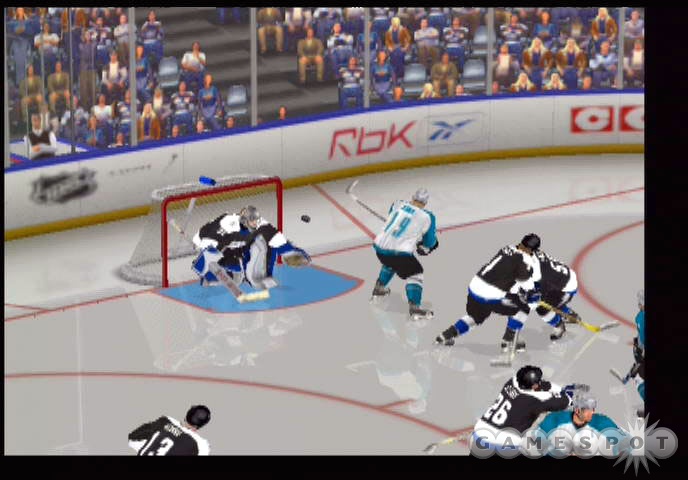
For 2K6, the developers have actually thrown together quite a number of new gameplay features. We say thrown together, because in some ways the gameplay feels more chaotic due to all these new components, some of which are excellent, and some of which are not. Starting with the positives, the best new aspect of the game is the new pro control passing system. One of the problems with setting up good plays in hockey games has been trying to accurately pass to all the right players in a proper succession. This has been nearly impossible with the standard passing mechanics. Here, you can simply click the right analog stick, and button icons will appear above each of the other four players on the ice. You need only press the corresponding button, and the pass will be sent to the right player. This gives you the ability to create lengthy strings of passes that can be especially effective on power plays. The defensive artificial intelligence won't just let you pull these plays off easily, of course, but if you can get past them, you can pull off some extremely satisfying goals. The one annoying thing about this feature is that you have to reclick the button to bring up the icons after every shot attempt. Maybe an option to just leave them on indefinitely would have been a good idea. But, even with this one minor gaffe, the feature is great.
Another great idea added into this year's game is on-the-fly play-calling. The D pad is utilized here to let you tell your team exactly what you want it to do. This works on both offense and defense, and by pressing specific directions you can have your team do everything from crash the net and screen the goalie to clearing the front of the net and collapsing. When these plays work, they're immensely effective, as the AI does pretty much exactly what you tell it to do. We did run into some instances, though, where it seemed like defensemen in particular weren't quite doing their part on offensive plays, like crashing the net. They definitely come in closer when you ask them to, but they still hover very close to the blue line inside the offensive zone, and trying to utilize them without controlling them directly can be a hassle. But apart from these hiccups, the new play-calling system is a welcome addition.
Yet another good idea that isn't perhaps as well-put-together as it could have been in this year's game is the new enforcer system. Every NHL team has at least one serious tough guy who loves to intimidate the other team's players through rough play and occasional brawls. NHL 2K6 calls these players out by slapping a fat E icon on them that's impossible to miss while you play. If your enforcer does his job especially well while he's on the ice, then opposing players may become intimidated, which is denoted by a big I icon for said player. Intimidated players will also take hits to their stats, most noticeably speed, for some reason. It's kind of odd that a player frightened by the presence of an enforcer would suddenly slow down--if anything, you'd think he'd want to speed up to stay out of the enforcer's way. Apart from that weird bit, the mechanic makes sense and works. The unfortunate thing, however, is that there's never any recourse. The enforcer from the team with the intimidated player never comes out and tries to start a fight--at least, not on the default settings. Fights are incredibly rare in the game, and when they do happen, they aren't much fun. Then again, 2K's fighting model has never been very good, although fights should still happen with far more frequency than they do in 2K6.
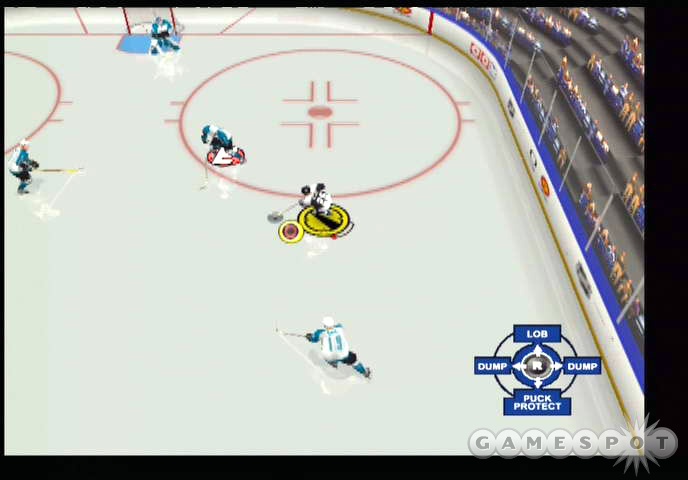
The last big change to 2K6's gameplay is the most incidental, which is interesting, since it involves the new goalie controls. It's a feature that seems like it ought to be a bigger deal, since Marty Turco is on the cover, and he's the first goalie to be on an NHL cover in ages. As it is, Kush has managed to make the act of playing the goalie manually much easier; it just hasn't made it more fun. The new goalie controls are highly simple. All you have to do is tap the right analog stick right or left to dive, tap it down to drop into the butterfly stance, tap up to poke-check the puck, and do a single button press to simply drop into the best save stance for the situation.
Control-wise, these functions do precisely what they're supposed to do. But ultimately they're defeated by the unwavering truth, which is that no game has managed to make playing a goalie useful, since no camera angle in the game does a good enough job of letting you actually see what's going on. Yes, the control functions are more fluid and useful here, but that's all completely negated when the camera isn't even close to being on the goalie. For example, an opposing forward rips a slap shot from near the blue line, and gets it in just because you couldn't even tell where your goaltender was on the ice. Yes, you can hold down the right trigger button to make the game auto-position your goalie, but this function isn't quick or intuitive enough to handle rebounds or quick one-timers. And any time you regain possession of the puck, you automatically transfer to the puck-handling player. It takes half a second of reaction time to switch back to the goalie if you want to, which leaves you seriously vulnerable during that time. Maybe it's time for Visual Concepts to bring back the old NFL first-person mode for the purposes of goaltending, because that seems like the only way it could be done well. What has been done here is an improvement from the utter uselessness that was goalie control previously, but it's still not a huge improvement. Fortunately, this is also the most easily ignored new feature of the game, as semiautomatic goalie control is still on by default, meaning you never have to touch it if you don't want to.
With all these changes and additions and tweaks to the gameplay, some might be wondering if the core game still feels as solid and realistic as it has in past years. The answer is absolutely yes. The pacing still feels completely perfect, moving fast at all the right times and generally feeling like a real game of hockey with lots of back-and-forth action. Realistic numbers of shots, goals, points, and practically every stat you can think of are typically on the postgame boards. The game still doesn't do a particularly good job of getting all your lines involved automatically, but tweaking the setting to manual line changes is all you need to do to correct this. As mentioned before, all the new rule changes are in effect in 2K6. We couldn't find anything missing from the list that's posted on NHL's Web site, so it looks like everything's up to speed. We can't say exactly whether or not the new rules really change the way the game plays--if anything, it seems pretty much the same to us. All told, though, 2K has delivered another extremely realistic and exciting game of hockey on the gameplay front. Though some of the changes might rub some people the wrong way, the overall flow of the game is as fantastic as it's ever been, and the AI can really be some of the most challenging out there when you up the difficulty.
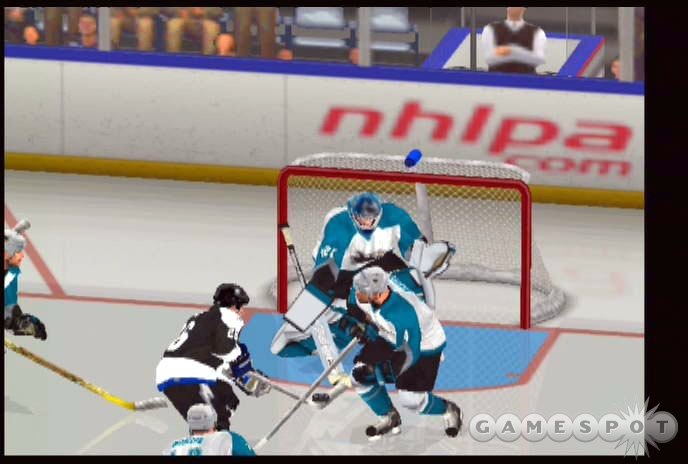
For 2K6, the developers have put together yet another incredibly deep roster of modes that is an absolute steal for the budget price of this package. The franchise mode by itself would be worth such a price. All the great features from last year, like international rookie scouting, contract negotiations, and staff communication are joined by a new practice mode and team chemistry. Practice mode lets you set up individual practices for your players, put together group scrimmages for the purposes of upping chemistry, and create individual skill drills for bonus stat upgrades. Practicing ties into the new fatigue system. Players, like in real life, will now become fatigued if they're overworked, so you'll need to strike a careful balance between how hard you practice them and how much game time they'll see during a week.
As for the chemistry system, it's not unlike the system that was introduced in EA's NHL 2005 last year. Players are broken up into four categories: scoring, skating, hard-nosed, and utility. Like the EA system, putting too many players of the same type together just doesn't work. Generally, it's good to have a single skater, a single scorer, and either a utility or hard-nosed player to complement them on a line. Having a line with good chemistry nets stat boosts for those players, and bad chemistry has a converse effect. The system is great, save for one annoying hitch: Sometimes chemistry on a line simply won't work for reasons that just aren't obvious. Part of it may have to do with the game's happiness measurement, which actually tracks how pleased a player is with his overall role on the team--sort of a morale tracker, of sorts. And sometimes players' happiness will just take big dips, even if they're getting significant play time. There's no communication with players via the e-mail system, so it's impossible to see what, if anything, is causing this dip. Fortunately, it's rare that such morale drops actually result in serious problems, but there are times when you may have to trade away a high-ranked player just because you can't make him happy.
For what it's worth, this year's franchise mode progresses like a real hockey season, more so than it ever has before. Trades are frequently offered, especially toward the trade deadline, and pretty much every offer makes sense on some level. For example, you won't see the CPU try to trade you Rick Nash for Alexander Suglabov, or vice versa. Free-agent bidding works similarly well, and although there's no definitive salary cap, each team has a hard budget that it can't go over, which is just about as good as a signified cap. Over time, rookies develop, older players retire, and things go on pretty much as they ought to. Some of the glitches that screwed up the experience last year have been definitively fixed here, too. The playoffs' injury bug that prevented players with minor injuries from returning during the playoffs is apparently no more (as we had several injuries over a few playoff series, and all returned). The CPU now actually knows how to auto-fill a line when an injury occurs (making it so you don't have to constantly jump out of a schedule simulation and reformat your lines yourself), and 2K has added in an interest meter for contract signings, which gives you an idea of how interested a free agent is in the money you're offering. These are all good fixes.
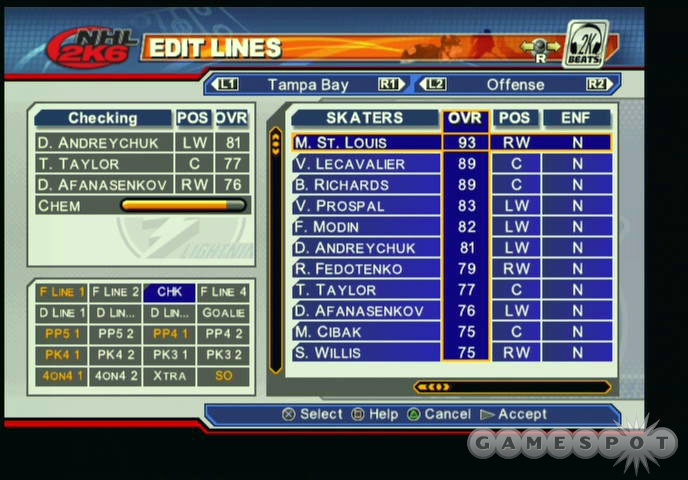
With that said, we still noticed a few glitches here and there in the franchise mode. For one, during a couple of different seasons, the standings would just stop registering overtime losses and shoot-out losses. As much as we'd like to believe that the NHL's want of higher scoring was purely the reasoning for this, it looks more like a stat-tracking glitch that just happens at random. Another issue comes from games played during franchise. Every once in a while, weird graphical glitches rear their ugly heads, like an entire game against Vancouver where goalie Dan Cloutier never had a helmet on. We weren't ever able to reproduce any single issue more than once, but generally speaking, it seems like franchise games are a little more prone to glitches than other modes.
Outside of franchise, all the modes that made their respective debuts last year are back once again. Party mode works fundamentally the same, but with some variations. There are 18 minigames in total, several more than in last year's game. All the games that were so much fun previously are just as fun here, but some of them just feel wildly overreaching. It's one thing to have a game where four players compete for one puck and try to score as many goals as they can into a net that has a blocker that goes up and down. It's quite another to have to do the same thing with a bunch of obstacles on the course, and periodically have to scramble to a musical chairs-like target in order to not have your point total drop. Frantic action is certainly what you would want in games like these, but in some cases, it feels like 2K just had to stretch these existing concepts too far to come up with something new. But hey, at least all the old games are still a blast.
Other modes included in 2K6 should sound pretty familiar as well. There's the dream team ladder, where you go up against teams put together by superstars like Marty Turco, Martin St. Louis, Jeremy Roenick, and the like; the skills competitions from the all-star weekend; the skybox mode, which houses all the stats for completed in-game challenges, as well as all your unlockables; and, of course, online play. The online functionality is precisely what you would expect, with basic quick games, tournaments, and league play all available. The lack of ESPN licensing hasn't prevented 2K from building a Web site stat-tracking system similar to last year's game, so you'll still have access to all those goodies. The online play itself works functionally the same as it always has, so while our mileage may have varied, all the games we played online were smooth and ranked properly. The one serious downside to the online, however, is the menu system. Simply put, this menu system is completely unintuitive and just plain weird. Certain button functions just don't do what they seem like they ought to, and other times completely random buttons will do key functions. For instance, if you get a challenge while sitting in a lobby, the only way to access it is by pressing down on the right analog stick to bring down a previously hidden menu, and the text denoting this is barely visible.
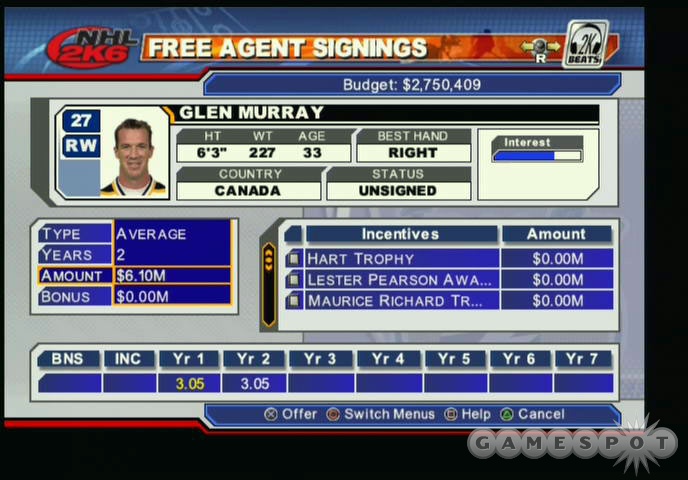
The online menus aren't the only ones that suffer from being terribly confusing. Even during the ESPN days, NHL 2K's menus have had problems, and this year they're exacerbated by the lack of a definitive look and feel. Button functions sometimes simply don't do what you would intuitively think they would, most of the stat and option menus in the game are just plain ugly, and everything has a kind of hacked-together feel to it. You can certainly get around the menus, but it's more of a pain than it ought to be.
Thankfully, the in-game graphics fare quite a bit better than the menus. Once again, 2K6 delivers some excellent player models, highly detailed player faces, and smooth on-ice animation. Some of the new goalie animations are especially good, but across the ice, everything moves great. The one area of the in-game visuals that suffers, though, is the between-play cutscenes. Frankly, they just don't look that great, and there aren't nearly enough of them, as you'll see plenty of repetition of random shots of the team owners and the crowd doing the wave. Between the two versions of the game, it should come as no shock that the Xbox version is the visually superior one. Apart from the usually cleaner look, the frame rate is also much more consistent on the Xbox than on the PS2.
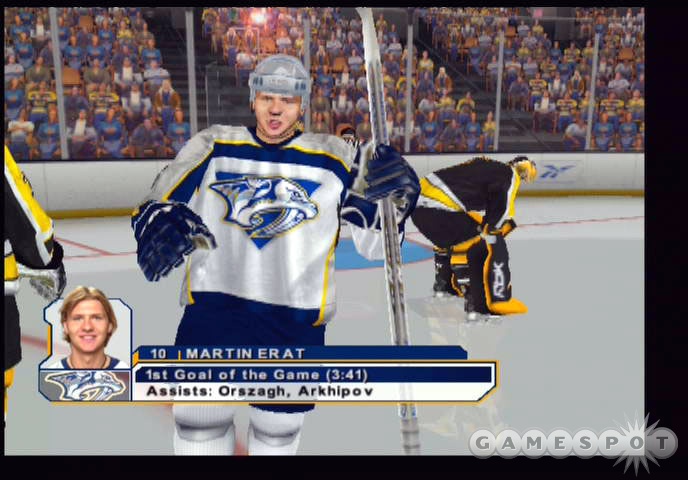
Perhaps the most depressing loss stemming from the ESPN license changeover (as well as ESPN's dropping of all things NHL from its television lineup) is the departure of commentators Bill Clement and Gary Thorne. The twosome delivered some of the best in-game commentary of any sports sim available, and sadly, they've been replaced by a significantly less-interesting team. Hockey Night in Canada announcers Bob Cole and Harry Neale are the twosome in this year's game, and while they're certainly not bad, they lack the kind of cohesive dialogue and rapport that made Thorne and Clement so fantastic. Not to mention that they rarely have anything especially insightful to say, and periodically they'll get things wrong on the play-by-play. Thankfully, the in-game sound effects are still great, from every ping of a puck going off the pipes to the sounds of helpless forwards getting driven into the boards. The soundtrack mainly consists of inoffensive rock music that you've probably never heard before, but it actually isn't too bad.
While NHL 2K6 is a bit of a downturn for the franchise, it remains a highly enjoyable game of hockey, thanks largely to its stellar gameplay. Sure, not every change made to the system is as useful or fun as it could have been, but the underlying engine is just as realistic as it has ever been. And, some changes--like the new passing system and play-calling--add even more depth to the package. Between this and the plethora of available features, it's really tough to argue with what NHL 2K6 offers, especially for its $20 price tag.